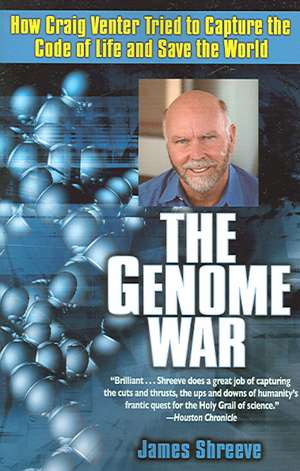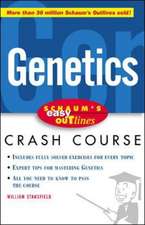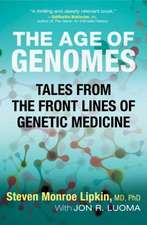The Genome War: How Craig Venter Tried to Capture the Code of Life and Save the World
Autor James Shreeveen Limba Engleză Paperback – 31 mai 2005
On May 10, 1998, biologist Craig Venter, director of the Institute for Genomic Research, announced that he was forming a private company that within three years would unravel the complete genetic code of human life—seven years before the projected finish of the U.S. government’s Human Genome Project. Venter hoped that by decoding the genome ahead of schedule, he would speed up the pace of biomedical research and save the lives of thousands of people. He also hoped to become very famous and very rich. Calling his company Celera (from the Latin for “speed”), he assembled a small group of scientists in an empty building in Rockville, Maryland, and set to work.
At the same time, the leaders of the government program, under the direction of Francis Collins, head of the National Human Genome Research Institute at the National Institutes of Health, began to mobilize an unexpectedly unified effort to beat Venter to the prize—knowledge that had the potential to revolutionize medicine and society.
The stage was set for one of the most thrilling—and important—dramas in the history of science. The Genome War is the definitive account of that drama—the race for the greatest prize biology has had to offer, told by a writer with exclusive access to Venter’s operation from start to finish. It is also the story of how one man’s ambition created a scientific Camelot where, for a moment, it seemed that the competing interests of pure science and commercial profit might be gloriously reconciled—and the national repercussions that resulted when that dream went awry.
From the Hardcover edition.
Preț: 120.71 lei
Nou
Puncte Express: 181
Preț estimativ în valută:
23.10€ • 23.98$ • 19.26£
23.10€ • 23.98$ • 19.26£
Carte disponibilă
Livrare economică 04-18 martie
Preluare comenzi: 021 569.72.76
Specificații
ISBN-13: 9780345433749
ISBN-10: 0345433742
Pagini: 403
Dimensiuni: 133 x 204 x 24 mm
Greutate: 0.32 kg
Editura: BALLANTINE BOOKS
ISBN-10: 0345433742
Pagini: 403
Dimensiuni: 133 x 204 x 24 mm
Greutate: 0.32 kg
Editura: BALLANTINE BOOKS
Notă biografică
James Shreeve is the author of The Neandertal Enigma: Solving the Mystery of Modern Human Origin, and coauthor of Lucy’s Child: The Discovery of a Human Ancestor. His articles have appeared in The Atlantic Monthly, Discover, National Geographic, Science, Smithsonian, and other publications. He has been a fellow of the Alfred P. Sloan Foundation and of the Alicia Patterson Foundation. Shreeve lives in South Orange, New Jersey.
From the Hardcover edition.
From the Hardcover edition.
Extras
CHAPTER 1
MAY 1998: "YOU CAN DO MOUSE"
On May 8 of that year, three months before the Nantucket race, Nicholas Wade, a veteran science writer for the New York Times, entered the lobby of the St. Regis hotel on Fifth Avenue. The day before, he had received a call from a public relations representative of the Perkin Elmer Corporation in suburban Connecticut, offering him an exclusive story on an exciting development. Wade was leery. Public relations people often overestimate the media interest in their company's announcements. In the brash, upstart world of biotechnology, moreover, Perkin Elmer was an unglamorous player--a maker of instruments, not news. But the PR rep mentioned that Craig Venter was a player in the new enterprise. Wade knew that Venter would not be involved in anything unglamorous. He agreed to meet with Perkin Elmer's executives over breakfast.
Wade crossed the lobby and squeezed into an elevator just as its doors began to close. A slightly built, mild-mannered Englishman in his fifties, the Times reporter attracted little attention from the dark-suited businessmen already in the elevator. In the Perkin Elmer suite on the fourteenth floor, he was introduced to CEO Tony White and two other company executives. One was Peter Barrett. The other was Michael Hunkapiller, head of Perkin Elmer's Applied Biosystems division, near San Francisco. Wade knew him by reputation. Largely unknown outside the biotech world, Hunkapiller was a legend within it. In the late 1980s, he had co-invented a machine that could automatically sequence DNA--that is, read out the order of a short stretch of chemical letters in the genetic code. Since then his technical genius and business acumen had made him the linchpin of an ongoing effort to develop better, faster instruments for sequencing DNA and speeding up other biotechnical processes.
A lavish breakfast buffet had been set up on a sideboard. Craig Venter was not in the room, but his voice greeted Wade from a speakerphone sitting on a coffee table. "Hey, Nick," he said, in a disarmingly mild tone. "Thanks for coming in so early. There's something we wanted you to be the first to know. Are you sitting down?"
Wade took a chair and opened his notebook. First Venter talked, then Hunkapiller, then Venter again at greater length. Tony White offered an occasional comment, in a broad southern drawl. No one touched the breakfast. Wade sat erect, furiously taking notes. He left an hour and a half later, certain that he had the lead story for the coveted front page of the Sunday edition of the Times.
"Genome" is not a pretty word. Even when you say it in a normal tone of voice, you sound like you're mumbling. It has so recently come into common usage that until 1997, almost a decade after the Human Genome Project began, Microsoft Word's spell-checker assumed that anyone writing about the enterprise had made a typo and corrected it to "the Human Gnome Project." In 1999, bioethicist Arthur Caplan of the University of Pennsylvania was invited to address a meeting of state legislators who were puzzled over the issue of human cloning. Caplan asked the lawmakers if they knew where their genome was located. Roughly one third answered that it was in the brain, and another third thought it was in the gonads. The others weren't sure.
In fact, two copies of your genome--one contributed by each of your parents--are spooled on the twenty-three chromosomes inside the nucleus of every one of your cells--brain, gonad, bone, skin, guts, muscle, mucus, and every other kind of cell, except for red blood. The spool is fantastically compact. Each copy is a double-stranded molecule of DNA only 79 billionths of an inch wide, but which, stretched out, would run almost six feet in length. Upon this attenuated thread--imagine a clothesline running the length of the United States, then back again--lie the chemical instructions that have informed the development of your body and brain from the moment you were conceived. The individual units of instruction are called genes. They are composed of strings of the four chemical bases of DNA: adenine, thymine, guanine, and cytosine--abbreviated A, T, G, and C by scientists. The cell's machinery forms the letters into a series of three-letter words that combined give the recipe for the construction of a specific protein: an enzyme that helps you digest a tuna sandwich, an antibody molecule marshaled to fight off an infection, a receptor protein in your brain that helps you read and understand this paragraph. There are a lot of extra letters in the genome, sloppily referred to as "junk DNA," which do not spell out protein recipes but may serve some other purpose, perhaps vital, perhaps not. The whole human genome contains about 3 billion letters, and is often compared to the text of a book. If you decided to read the book aloud and recited one letter every second, it would take you eleven years to get to the end.
Even if someone had eleven years to spare for such a project, a simple recitation of the DNA letters would give no hint whatsoever of the way the whole genome works to create and operate a human life. Instead of thinking of the genome as a book, imagine it as a piano keyboard. Each piano key represents one gene. If you press down on a key, you hear a single note: the protein that the gene expresses. If you press the key again, you will hear the same note again, monotonously, every time the key is played. But with a piano keyboard, you can do much more than play lots of individual notes. You can combine the notes to make music. Just so, our various cell types play upon the long, thin keyboard of the genome: they combine notes, playing some genes together as chords, tripping several together in a phrase, gathering bundles of notes to create the complex and wonderful effects that find expression in our biological being. Just as a pianist doesn't play all the piano keys in every piece, only some of the genes get played in the cell types of each organ. Sonata in the Key of Kidney. The Heart Fantasia. Variations on the Theme of Brain.
Beautiful music, all of it. But think what can happen to a piano sonata if an important key on the piano sticks, or sounds the wrong note when struck. Such a flaw will ruin every passage in which that key is played. In some cases, it will destroy the music entirely. In the United States, one child out of every four thousand is born with cystic fibrosis, which is caused by a defective gene on chromosome 7. Children with this particular stuck key have abnormally thick mucus in their lungs, leaving them vulnerable to repeated infections that erode the lungs' tissues and eventually the ability to breathe. Most will die before their thirtieth birthday. In another gene, nothing more than a substitution of a T for an A causes sickle-cell anemia. Huntington's disease, a slow, inescapable meltdown of the brain, occurs because a gene near the top of chromosome 4 contains a series of repeated stutters on the letters CAG, playing them over and over like a scratched recording. The patient goes mad and inevitably dies.
Single-gene alterations account for some three thousand to four thousand other inherited diseases. Hard as these defects are to track down, they are by far the easiest targets for gene hunters. Most diseases, including such common killers as cancer and heart disease, stem from disruptions in the interaction among several genes and between genes and the environment. To find their causes, you have to first know what all the keys on the piano are. You have to know the whole genome. This knowledge will not lead directly to a cure for cancer and other killers, but by 1998 even the scientists who had originally opposed the Human Genome Project as ill conceived and not cost-effective were utterly convinced that its fruit would be well worth the $3 billion investment of taxpayer money. The major pharmaceutical companies were betting that it would lead to new drugs worth a whole lot more.
After leaving the St. Regis, Nicholas Wade tried to reach Francis Collins, the head of the government's genome project, whose official title was director of the National Human Genome Research Institute (NHGRI), one of the National Institutes of Health. Collins, more or less against his will, was on a plane headed from Newark to Dulles Airport, where he would catch a flight to Los Angeles. He had originally been scheduled to fly straight from Newark to LA, where he was due to give a lecture the next morning. But the evening before, he had gotten a phone call. The mere sound of Venter's voice on the line gave Collins a shiver of apprehension.
"Francis, I think you need to know about something we're about to announce," Venter said. "We have to meet with you right away."
"Who is 'we'?" Collins asked.
"I can't tell you that," Venter replied. "I don't mean to sound coy. I'm just not authorized to talk about it yet."
The two men had known each other for over a decade. When they were first introduced, Craig Venter was an obscure forty-year-old researcher in the National Institute for Neurological Diseases and Stroke, also part of the NIH. He had not attended college until after service in Vietnam, and thus had begun his career in academic science relatively late. Francis Collins was several years younger but well on his way to becoming perhaps the most famous gene hunter in the world. Soon he would claim a share of the credit for the discovery of five disease-related genes, including two of the most important ones yet found, those responsible for cystic fibrosis and Huntington's disease. In 1994, his success took him to one of the most prominent scientific posts in the country. At the age of forty-three, he was enticed by the secretary of health and human services to leave his large, heavily funded laboratory at the University of Michigan and come to Bethesda, Maryland, to assume leadership of the Human Genome Project, then in its fourth year. The job change meant a cut in pay and much less time for research, but Collins would be in charge of a $200 million annual budget earmarked for an historic enterprise. The decision was a no-brainer. "There is only one human genome program," Collins said when he took the post. "It will only happen once, and this is that moment in history. The chance to stand at the helm of that project and put my own personal stamp on it is more than I could imagine."
Now, four years later, Collins still saw himself as the captain of a great ship moving steadily toward its destination. It would be easy to imagine him at the helm, eyes trained on the horizon off the bow. A gangly six-foot-four, he had a long, broad face with features that competed for attention--nose and ears commandingly prominent, an ample but neat mustache, and sharp blue eyes magnified slightly by oversize glasses. He was in the habit of combing his hair forward, which gave him a kind of folksy, unpolished look. While outwardly easygoing--he often rode a motorcycle to work and occasionally played electric guitar with other scientists in a middle-aged rock band--there was a deliberate resoluteness in the line of his mouth and in the way he drove home a point with his chin up high.
The Human Genome Project was a command requiring a great deal of confidence and political will. To keep the money flowing into the program from Congress, Collins needed to constantly reassure lawmakers about the virtue of an enterprise whose costs were huge and whose payoff was distant and abstract--a perilous combination, especially in a Republican Congress. But overseeing how the money was spent required an even firmer grip on the helm. Big Science attracts big egos, and those leading the laboratories funded by NHGRI were some of the biggest around, all competing for the largest possible slice of Collins's considerable pie.
The managerial challenge had been woefully obvious at a contentious meeting of the leading project scientists in Bethesda the preceding December. The pilot sequencing projects were almost over, the full-scale attack on the human code was about to begin, and it was time to take a hard look at what the final phase of this fifteen-year project was going to cost. Since the project's inception, the price of the sequencing of the human genome had been estimated at around $1.5 billion, or about fifty cents for each of the DNA letters in the 3-billion-letter sequence. But would it cost more? Could it be done for less? Collins had called the meeting to decide the question communally; unfortunately, the various genome centers were all competing with one another for the millions his institute was about to distribute to finance the sequencing--a situation made worse by the presence of some outside scientists who were likely to be sitting on the grant-review panel deciding on who got how much. Before long, an inverted bidding war broke out, as one scientist after another lowballed his cost estimates to show how he could sequence a base pair cheaper than the previous speaker. The numbers were extremely speculative, since DNA sequencing on a large scale had yet to be tried and the technology to do it was still evolving. The tone began to get nasty. Cries of "You're cooking your books!" and "You're lying!" bounded off the walls. The cost of human code hit rock bottom near the lunch break, when one scientist from a small genome center in Texas confidently declared that he could sequence DNA at the rate of eleven cents per base pair. Over the break, however, people began to realize that they were goading one another in a dangerous direction. If the Human Genome Project's work could be done so cheaply, what justification would they have for maintaining, much less increasing, the program's budget from Congress? The debate resumed, but now the price of a base pair began to rise. People voiced their concern about the new technologies: How can we be sure they are going to work? Do we really want to run the risk of cutting back on quality to save money, when the code of human life is at stake? Thirty cents per base pair was more realistic. No, better make that forty. Maynard Olson of the University of Washington, a passionate advocate of high-quality standards, declared that no sequence of human code should be called "finished" unless it contained no more than a single incorrect base pair in a string of half a million. That level of accuracy might take more time, and if amortized properly the cost might be as much as twenty dollars a base pair. The price would go down as technology advanced, but in the meantime, Olson declared, any sequence that did not cross that threshold should not be counted as done at all. "People will forgive you for being slow," he warned, "but they won't forgive you for being sloppy." But none of the other genome center leaders, and especially those running large operations that had invested most heavily in automated equipment, could possibly come so close to perfection. At the end of the day, the scientists soberly agreed that the current estimate for the cost of sequencing a base pair should be...fifty cents, where the bidding had started. The meeting then adjourned.
Presiding over such a scene as this ("the low point of the Human Genome Project," according to one of the participants), Francis Collins could only struggle to keep order and hide any panic he might be feeling behind his inextinguishable smile. For the most part, the problem lay not with him or his squabbling generals but in the philosophy of the Human Genome Project itself. One of its major arguments was that only the best and brightest in biomedical research should be in charge of something so essential to the understanding of human life and human disease. The way to ensure excellence was through NIH's competitive grant-based funding system, the mechanism driving the most spectacular discovery machine in the history of the world. But sequencing DNA is not discovery-driven science. Developing the tools and insights to capture the human code certainly takes great intelligence, even genius, but it is not experimental research in the traditional sense, where hypotheses compete to explain how nature works, leading ever nearer to the truth. It is more like a massive construction project, closer to building the pyramids than to finding a cure for cancer. But what was under construction was the biological essence of a human being. What single entity could be trusted with such a precious charge? The undertaking had to be collective. Given the decentralization built into the design of the project, the progress that had been made by the end of 1997 was respectable. But more than one scientist left that December meeting shaking his head, convinced there was no way the program would deliver a completed genome by the project deadline of 2005, much less anytime sooner.
From the Hardcover edition.
MAY 1998: "YOU CAN DO MOUSE"
On May 8 of that year, three months before the Nantucket race, Nicholas Wade, a veteran science writer for the New York Times, entered the lobby of the St. Regis hotel on Fifth Avenue. The day before, he had received a call from a public relations representative of the Perkin Elmer Corporation in suburban Connecticut, offering him an exclusive story on an exciting development. Wade was leery. Public relations people often overestimate the media interest in their company's announcements. In the brash, upstart world of biotechnology, moreover, Perkin Elmer was an unglamorous player--a maker of instruments, not news. But the PR rep mentioned that Craig Venter was a player in the new enterprise. Wade knew that Venter would not be involved in anything unglamorous. He agreed to meet with Perkin Elmer's executives over breakfast.
Wade crossed the lobby and squeezed into an elevator just as its doors began to close. A slightly built, mild-mannered Englishman in his fifties, the Times reporter attracted little attention from the dark-suited businessmen already in the elevator. In the Perkin Elmer suite on the fourteenth floor, he was introduced to CEO Tony White and two other company executives. One was Peter Barrett. The other was Michael Hunkapiller, head of Perkin Elmer's Applied Biosystems division, near San Francisco. Wade knew him by reputation. Largely unknown outside the biotech world, Hunkapiller was a legend within it. In the late 1980s, he had co-invented a machine that could automatically sequence DNA--that is, read out the order of a short stretch of chemical letters in the genetic code. Since then his technical genius and business acumen had made him the linchpin of an ongoing effort to develop better, faster instruments for sequencing DNA and speeding up other biotechnical processes.
A lavish breakfast buffet had been set up on a sideboard. Craig Venter was not in the room, but his voice greeted Wade from a speakerphone sitting on a coffee table. "Hey, Nick," he said, in a disarmingly mild tone. "Thanks for coming in so early. There's something we wanted you to be the first to know. Are you sitting down?"
Wade took a chair and opened his notebook. First Venter talked, then Hunkapiller, then Venter again at greater length. Tony White offered an occasional comment, in a broad southern drawl. No one touched the breakfast. Wade sat erect, furiously taking notes. He left an hour and a half later, certain that he had the lead story for the coveted front page of the Sunday edition of the Times.
"Genome" is not a pretty word. Even when you say it in a normal tone of voice, you sound like you're mumbling. It has so recently come into common usage that until 1997, almost a decade after the Human Genome Project began, Microsoft Word's spell-checker assumed that anyone writing about the enterprise had made a typo and corrected it to "the Human Gnome Project." In 1999, bioethicist Arthur Caplan of the University of Pennsylvania was invited to address a meeting of state legislators who were puzzled over the issue of human cloning. Caplan asked the lawmakers if they knew where their genome was located. Roughly one third answered that it was in the brain, and another third thought it was in the gonads. The others weren't sure.
In fact, two copies of your genome--one contributed by each of your parents--are spooled on the twenty-three chromosomes inside the nucleus of every one of your cells--brain, gonad, bone, skin, guts, muscle, mucus, and every other kind of cell, except for red blood. The spool is fantastically compact. Each copy is a double-stranded molecule of DNA only 79 billionths of an inch wide, but which, stretched out, would run almost six feet in length. Upon this attenuated thread--imagine a clothesline running the length of the United States, then back again--lie the chemical instructions that have informed the development of your body and brain from the moment you were conceived. The individual units of instruction are called genes. They are composed of strings of the four chemical bases of DNA: adenine, thymine, guanine, and cytosine--abbreviated A, T, G, and C by scientists. The cell's machinery forms the letters into a series of three-letter words that combined give the recipe for the construction of a specific protein: an enzyme that helps you digest a tuna sandwich, an antibody molecule marshaled to fight off an infection, a receptor protein in your brain that helps you read and understand this paragraph. There are a lot of extra letters in the genome, sloppily referred to as "junk DNA," which do not spell out protein recipes but may serve some other purpose, perhaps vital, perhaps not. The whole human genome contains about 3 billion letters, and is often compared to the text of a book. If you decided to read the book aloud and recited one letter every second, it would take you eleven years to get to the end.
Even if someone had eleven years to spare for such a project, a simple recitation of the DNA letters would give no hint whatsoever of the way the whole genome works to create and operate a human life. Instead of thinking of the genome as a book, imagine it as a piano keyboard. Each piano key represents one gene. If you press down on a key, you hear a single note: the protein that the gene expresses. If you press the key again, you will hear the same note again, monotonously, every time the key is played. But with a piano keyboard, you can do much more than play lots of individual notes. You can combine the notes to make music. Just so, our various cell types play upon the long, thin keyboard of the genome: they combine notes, playing some genes together as chords, tripping several together in a phrase, gathering bundles of notes to create the complex and wonderful effects that find expression in our biological being. Just as a pianist doesn't play all the piano keys in every piece, only some of the genes get played in the cell types of each organ. Sonata in the Key of Kidney. The Heart Fantasia. Variations on the Theme of Brain.
Beautiful music, all of it. But think what can happen to a piano sonata if an important key on the piano sticks, or sounds the wrong note when struck. Such a flaw will ruin every passage in which that key is played. In some cases, it will destroy the music entirely. In the United States, one child out of every four thousand is born with cystic fibrosis, which is caused by a defective gene on chromosome 7. Children with this particular stuck key have abnormally thick mucus in their lungs, leaving them vulnerable to repeated infections that erode the lungs' tissues and eventually the ability to breathe. Most will die before their thirtieth birthday. In another gene, nothing more than a substitution of a T for an A causes sickle-cell anemia. Huntington's disease, a slow, inescapable meltdown of the brain, occurs because a gene near the top of chromosome 4 contains a series of repeated stutters on the letters CAG, playing them over and over like a scratched recording. The patient goes mad and inevitably dies.
Single-gene alterations account for some three thousand to four thousand other inherited diseases. Hard as these defects are to track down, they are by far the easiest targets for gene hunters. Most diseases, including such common killers as cancer and heart disease, stem from disruptions in the interaction among several genes and between genes and the environment. To find their causes, you have to first know what all the keys on the piano are. You have to know the whole genome. This knowledge will not lead directly to a cure for cancer and other killers, but by 1998 even the scientists who had originally opposed the Human Genome Project as ill conceived and not cost-effective were utterly convinced that its fruit would be well worth the $3 billion investment of taxpayer money. The major pharmaceutical companies were betting that it would lead to new drugs worth a whole lot more.
After leaving the St. Regis, Nicholas Wade tried to reach Francis Collins, the head of the government's genome project, whose official title was director of the National Human Genome Research Institute (NHGRI), one of the National Institutes of Health. Collins, more or less against his will, was on a plane headed from Newark to Dulles Airport, where he would catch a flight to Los Angeles. He had originally been scheduled to fly straight from Newark to LA, where he was due to give a lecture the next morning. But the evening before, he had gotten a phone call. The mere sound of Venter's voice on the line gave Collins a shiver of apprehension.
"Francis, I think you need to know about something we're about to announce," Venter said. "We have to meet with you right away."
"Who is 'we'?" Collins asked.
"I can't tell you that," Venter replied. "I don't mean to sound coy. I'm just not authorized to talk about it yet."
The two men had known each other for over a decade. When they were first introduced, Craig Venter was an obscure forty-year-old researcher in the National Institute for Neurological Diseases and Stroke, also part of the NIH. He had not attended college until after service in Vietnam, and thus had begun his career in academic science relatively late. Francis Collins was several years younger but well on his way to becoming perhaps the most famous gene hunter in the world. Soon he would claim a share of the credit for the discovery of five disease-related genes, including two of the most important ones yet found, those responsible for cystic fibrosis and Huntington's disease. In 1994, his success took him to one of the most prominent scientific posts in the country. At the age of forty-three, he was enticed by the secretary of health and human services to leave his large, heavily funded laboratory at the University of Michigan and come to Bethesda, Maryland, to assume leadership of the Human Genome Project, then in its fourth year. The job change meant a cut in pay and much less time for research, but Collins would be in charge of a $200 million annual budget earmarked for an historic enterprise. The decision was a no-brainer. "There is only one human genome program," Collins said when he took the post. "It will only happen once, and this is that moment in history. The chance to stand at the helm of that project and put my own personal stamp on it is more than I could imagine."
Now, four years later, Collins still saw himself as the captain of a great ship moving steadily toward its destination. It would be easy to imagine him at the helm, eyes trained on the horizon off the bow. A gangly six-foot-four, he had a long, broad face with features that competed for attention--nose and ears commandingly prominent, an ample but neat mustache, and sharp blue eyes magnified slightly by oversize glasses. He was in the habit of combing his hair forward, which gave him a kind of folksy, unpolished look. While outwardly easygoing--he often rode a motorcycle to work and occasionally played electric guitar with other scientists in a middle-aged rock band--there was a deliberate resoluteness in the line of his mouth and in the way he drove home a point with his chin up high.
The Human Genome Project was a command requiring a great deal of confidence and political will. To keep the money flowing into the program from Congress, Collins needed to constantly reassure lawmakers about the virtue of an enterprise whose costs were huge and whose payoff was distant and abstract--a perilous combination, especially in a Republican Congress. But overseeing how the money was spent required an even firmer grip on the helm. Big Science attracts big egos, and those leading the laboratories funded by NHGRI were some of the biggest around, all competing for the largest possible slice of Collins's considerable pie.
The managerial challenge had been woefully obvious at a contentious meeting of the leading project scientists in Bethesda the preceding December. The pilot sequencing projects were almost over, the full-scale attack on the human code was about to begin, and it was time to take a hard look at what the final phase of this fifteen-year project was going to cost. Since the project's inception, the price of the sequencing of the human genome had been estimated at around $1.5 billion, or about fifty cents for each of the DNA letters in the 3-billion-letter sequence. But would it cost more? Could it be done for less? Collins had called the meeting to decide the question communally; unfortunately, the various genome centers were all competing with one another for the millions his institute was about to distribute to finance the sequencing--a situation made worse by the presence of some outside scientists who were likely to be sitting on the grant-review panel deciding on who got how much. Before long, an inverted bidding war broke out, as one scientist after another lowballed his cost estimates to show how he could sequence a base pair cheaper than the previous speaker. The numbers were extremely speculative, since DNA sequencing on a large scale had yet to be tried and the technology to do it was still evolving. The tone began to get nasty. Cries of "You're cooking your books!" and "You're lying!" bounded off the walls. The cost of human code hit rock bottom near the lunch break, when one scientist from a small genome center in Texas confidently declared that he could sequence DNA at the rate of eleven cents per base pair. Over the break, however, people began to realize that they were goading one another in a dangerous direction. If the Human Genome Project's work could be done so cheaply, what justification would they have for maintaining, much less increasing, the program's budget from Congress? The debate resumed, but now the price of a base pair began to rise. People voiced their concern about the new technologies: How can we be sure they are going to work? Do we really want to run the risk of cutting back on quality to save money, when the code of human life is at stake? Thirty cents per base pair was more realistic. No, better make that forty. Maynard Olson of the University of Washington, a passionate advocate of high-quality standards, declared that no sequence of human code should be called "finished" unless it contained no more than a single incorrect base pair in a string of half a million. That level of accuracy might take more time, and if amortized properly the cost might be as much as twenty dollars a base pair. The price would go down as technology advanced, but in the meantime, Olson declared, any sequence that did not cross that threshold should not be counted as done at all. "People will forgive you for being slow," he warned, "but they won't forgive you for being sloppy." But none of the other genome center leaders, and especially those running large operations that had invested most heavily in automated equipment, could possibly come so close to perfection. At the end of the day, the scientists soberly agreed that the current estimate for the cost of sequencing a base pair should be...fifty cents, where the bidding had started. The meeting then adjourned.
Presiding over such a scene as this ("the low point of the Human Genome Project," according to one of the participants), Francis Collins could only struggle to keep order and hide any panic he might be feeling behind his inextinguishable smile. For the most part, the problem lay not with him or his squabbling generals but in the philosophy of the Human Genome Project itself. One of its major arguments was that only the best and brightest in biomedical research should be in charge of something so essential to the understanding of human life and human disease. The way to ensure excellence was through NIH's competitive grant-based funding system, the mechanism driving the most spectacular discovery machine in the history of the world. But sequencing DNA is not discovery-driven science. Developing the tools and insights to capture the human code certainly takes great intelligence, even genius, but it is not experimental research in the traditional sense, where hypotheses compete to explain how nature works, leading ever nearer to the truth. It is more like a massive construction project, closer to building the pyramids than to finding a cure for cancer. But what was under construction was the biological essence of a human being. What single entity could be trusted with such a precious charge? The undertaking had to be collective. Given the decentralization built into the design of the project, the progress that had been made by the end of 1997 was respectable. But more than one scientist left that December meeting shaking his head, convinced there was no way the program would deliver a completed genome by the project deadline of 2005, much less anytime sooner.
From the Hardcover edition.
Descriere
In this dramatic story of biologist Craig Venter, Shreeve details the race to solve history's greatest scientific challenge--the sequencing of the human genome.












